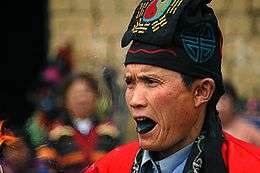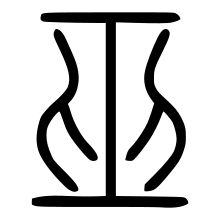Chinese shamanism
Chinese shamanism, alternatively called Wuism (Chinese: 巫教; pinyin: wū jiào; lit.: 'wu religion, shamanism, witchcraft'; alternatively 巫觋宗教 wū xí zōngjiào), refers to the shamanic religious tradition of China.[1][2] Its features are especially connected to the ancient Neolithic cultures such as the Hongshan culture.[3] Chinese shamanic traditions are intrinsic to Chinese folk religion.[4]
| Part of a series on |
| Chinese folk religion |
|---|
 |
|
Theory
Model humanity: |
|
Institutions and temples |
|
Internal traditions Major cultural forms
Main philosophical traditions: Ritual traditions: Devotional traditions: Zhenkong, "Void of Truth". Confucian churches and sects:
|
|
Related religions
|
Various ritual traditions are rooted in original Chinese shamanism: contemporary Chinese ritual masters are sometimes identified as wu by outsiders,[5] though most orders don't self-identify as such. Also Taoism has some of its origins from Chinese shamanism:[1][6] it developed around the pursuit of long life (shou 壽/寿), or the status of a xian (仙, "mountain man", "holy man").[1]
Meaning of wu

The Chinese word wu 巫 "shaman, wizard", indicating a person who can mediate with the powers generating things (the etymological meaning of "spirit", "god", or nomen agentis, virtus, energeia), was first recorded during the Shang dynasty (ca. 1600-1046 BCE), when a wu could be either sex. During the late Zhou dynasty (1045-256 BCE) wu was used to specify "female shaman; sorceress" as opposed to xi 覡 "male shaman; sorcerer" (which first appears in the 4th century BCE Guoyu). Other sex-differentiated shaman names include nanwu 男巫 for "male shaman; sorcerer; wizard"; and nüwu 女巫, wunü 巫女, wupo 巫婆, and wuyu 巫嫗 for "female shaman; sorceress; witch".
The word tongji 童乩 (lit. "youth diviner") "shaman; spirit-medium" is a near-synonym of wu. Modern Chinese distinguishes native wu from "Siberian shaman": saman 薩滿 or saman 薩蠻; and from Indian Shramana "wandering monk; ascetic": shamen 沙門, sangmen 桑門, or sangmen 喪門.
Berthold Laufer (1917:370) proposed an etymological relation between Mongolian bügä "shaman", Turkish bögü "shaman", Chinese bu, wu (shaman), buk, puk (to divine), and Tibetan aba (pronounced ba, sorcerer). Coblin (1986:107) puts forward a Sino-Tibetan root *mjaɣ "magician; sorcerer" for Chinese wu < mju < *mjag 巫 "magician; shaman" and Written Tibetan 'ba'-po "sorcerer" and 'ba'-mo "sorcereress" (of the Bön religion). Further connections are to the bu-mo priests of Zhuang Shigongism and the bi-mo priests of Bimoism, the Yi indigenous faith. Also Korean mu 무 (of Muism) is cognate to Chinese wu 巫.
Early history
The Chinese religion from the Shang dynasty onwards developed around ancestral worship.[1] The main gods from this period are not forces of nature in the Sumerian way, but deified virtuous men.[1] The ancestors of the emperors were called di (帝), and the greatest of them was called Shangdi (上帝, "the Highest Lord").[1] He is identified with the dragon (Kui 夔), symbol of the universal power (qi).[1]
Cosmic powers dominate nature: the Sun, the Moon, stars, winds and clouds were considered informed by divine energies.[1] The earth god is She (社) or Tu (土).[1] The Shang period had two methods to enter in contact with divine ancestors: the first is the numinous-mystical wu (巫) practice, involving dances and trances; and the second is the method of the oracle bones, a rational way.[1]
The Zhou dynasty, succeeding the Shang, was more rooted in an agricultural worldview.[1] They opposed the ancestor-gods of the Shang, and gods of nature became dominant.[1] The utmost power in this period was named Tian (天, "heaven").[1] With Di (地, "earth") he forms the whole cosmos in a complementary duality.[1]
Qing period
The Manchu rulers of the Qing dynasty (1636–1912) introduced substantial elements of Tungusic shamanism to China. Hong Taiji (1592–1643) put shamanistic practices in the service of the state, notably by forbidding others to erect new shrines (tangse) for ritual purposes. In the 1620s and 1630s, the Qing ruler conducted shamanic sacrifices at the tangse of Mukden, the Qing capital. In 1644, as soon as the Qing seized Beijing to begin their conquest of China, they named it their new capital and erected an official shamanic shrine there. In the Beijing tangse and in the women's quarters of the Forbidden City, Qing emperors and professional shamans (usually women) conducted shamanic ceremonies until the abdication of the dynasty in 1912.
In 1747 the Qianlong Emperor (r. 1735–1796) commissioned the publication of a Shamanic Code to revive and regulate shamanic practices, which he feared were becoming lost. He had it distributed to Bannermen to guide their practice, but we know very little about the effect of this policy. Mongols and Han Chinese were forbidden to attend shamanic ceremonies. Partly because of their secret aspect, these rituals attracted the curiosity of Beijing dwellers and visitors to the Qing capital. French Jesuit Joseph-Marie Amiot published a study on the Shamanic Code, "Rituels des Tartares Mandchous déterminés et fixés par l'empereur comme chef de sa religion" (1773). In 1777 the Qianlong Emperor ordered the code translated into Chinese for inclusion in the Siku quanshu. The Manchu version was printed in 1778, whereas the Chinese-language edition, titled Qinding Manzhou jishen jitian dianli (欽定滿洲祭神祭天典禮), was completed in 1780 or 1782.[7] Even though this "Shamanic Code" did not fully unify shamanic practice among the Bannermen, it "helped systematize and reshape what had been a very fluid and diverse belief system."[8]
Northeast shamanism
Shamanism is practiced in Northeast China and is considered different from those of central and southern Chinese folk religion, as it resulted from interaction of Han religion with folk religion practices of other Tungustic people such as Manchu shamanism. The shaman would perform various ritual functions for groups of believers and local communities, such as moon drum dance and chūmǎxiān (出馬仙 "riding for the immortals").
References
- Libbrecht 2007, p. 43.
- Werner Eichhorn, Die Religionen Chinas, 1973, pp. 55-70.
- Nelson, Matson, Roberts, Rock, Stencel. 2006.
- Hong Zhang and Constantine Hriskos, "Contemporary Chinese Shamanism:The Reinvention of Tradition". www.culturalsurvival.org. 2003.
- Nadeau, 2012. p. 140
- Waldau, Patton. 2009. p. 280
- di Cosmo, Nicola (1999), "Manchu shamanic ceremonies at the Qing court", in McDermott, Joseph P. (ed.), State and Court Ritual in China, Cambridge: Cambridge University Press, p. 355, note 5 (Manchu text printed in 1778, Chinese text completed in 1782); Rawski, Evelyn S. (1998), The Last Emperors: A Social History of Qing Imperial Institutions, p. 240 (Chinese text completed in 1780).
- Rawski, Evelyn S. (1998), The Last Emperors: A Social History of Qing Imperial Institutions, p. 298"
Bibliography
- Libbrecht, Ulrich (2007). Within the Four Seas...: Introduction to Comparative Philosophy. Peeters Publishers. ISBN 9042918128.CS1 maint: ref=harv (link)
- Sarah M. Nelson, Rachel A. Matson, Rachel M. Roberts, Chris Rock, Robert E. Stencel. Archaeoastronomical Evidence for Wuism at the Hongshan Site of Niuheliang. 2006.
- Randall L. Nadeau. The Wiley-Blackwell Companion to Chinese Religions. John Wiley & Sons, 2012.
- Paul Waldau, Kimberley Patton. A Communion of Subjects: Animals in Religion, Science, and Ethics. Columbia University Press, 2009. ISBN 9780231136433
- Arthur Waley, The Nine Songs: a Study of Shamanism in Ancient China. London, 1955.
- Further
- Coblin, W. South. 1986. A Sinologist's Handlist of Sino-Tibetan Lexical Comparisons. 1986. Steyler Verlag.
- Laufer, Berthold. 1917. "Origin of the Word Shaman", American Anthropologist 19.3: 361-371.
- Mair, Victor H. 1990. "Old Sinitic *Myag, Old Persian Maguš and English Magician,” Early China 15: 27–47.
- Schuessler, Axel. 2007. An Etymological Dictionary of Old Chinese. University of Hawaii Press.
External links
- Hong Zhang, Constantine Hriskos. Contemporary Chinese Shamanism: The Reinvention of Tradition. On: Shamanisms and Survival issue 27.2 (Summer 2003).
- Max Dashu. Xi Wangmu, the shamanic great goddess of China.


